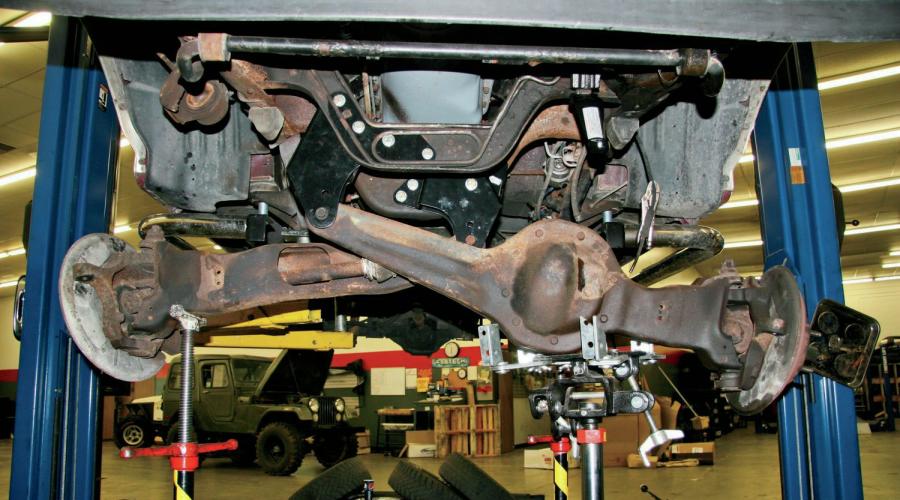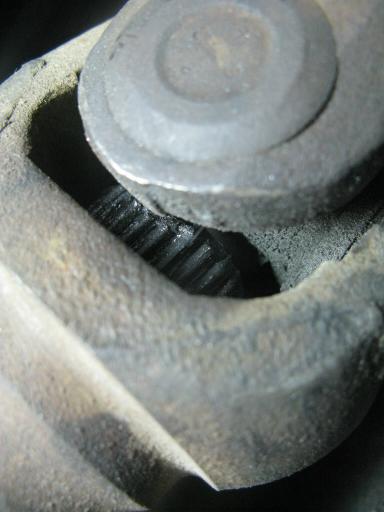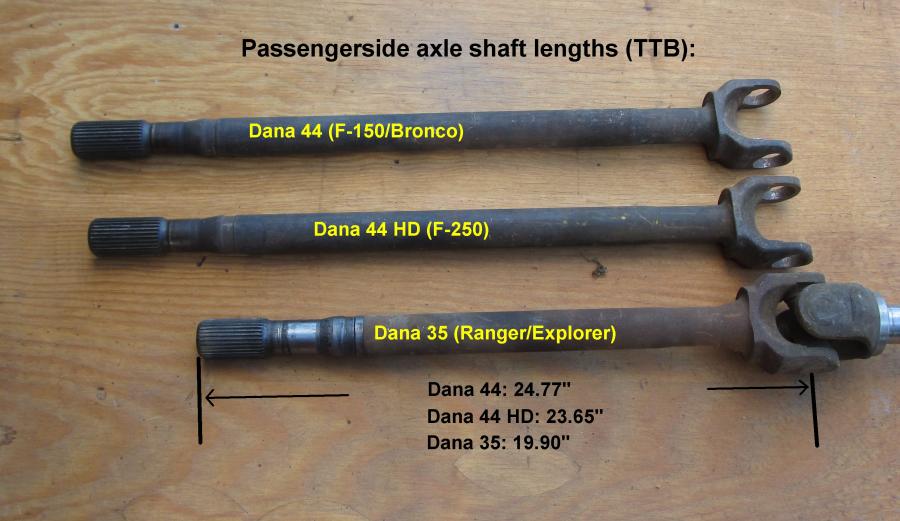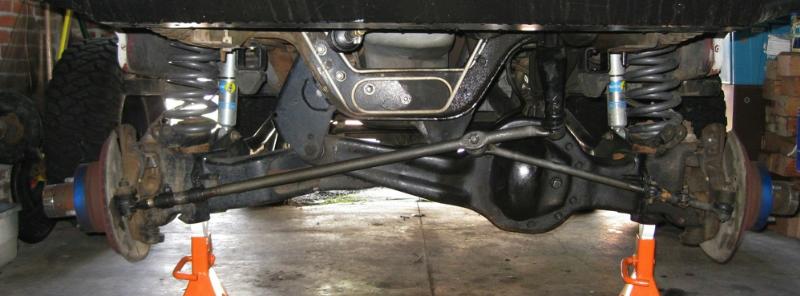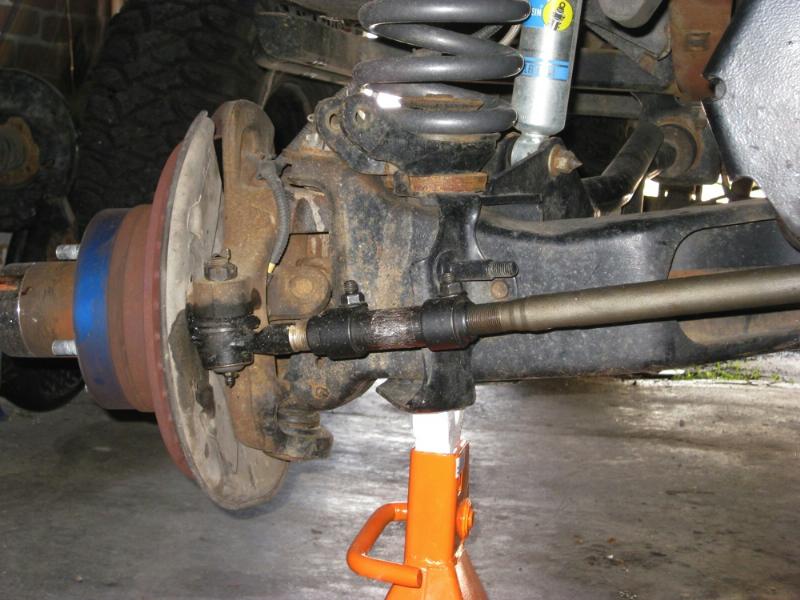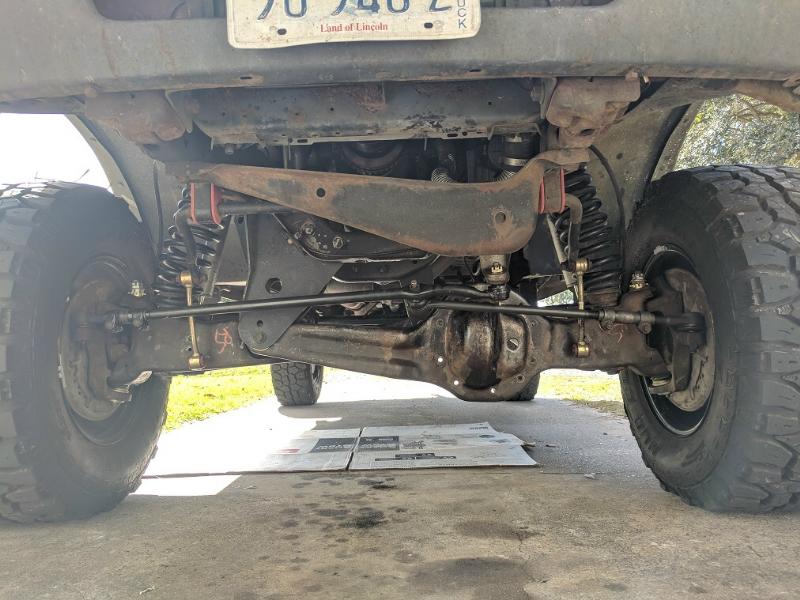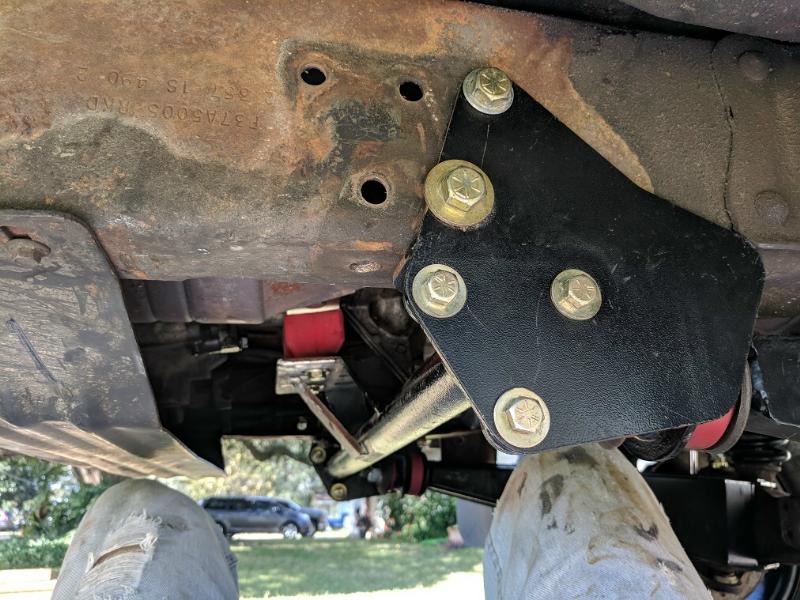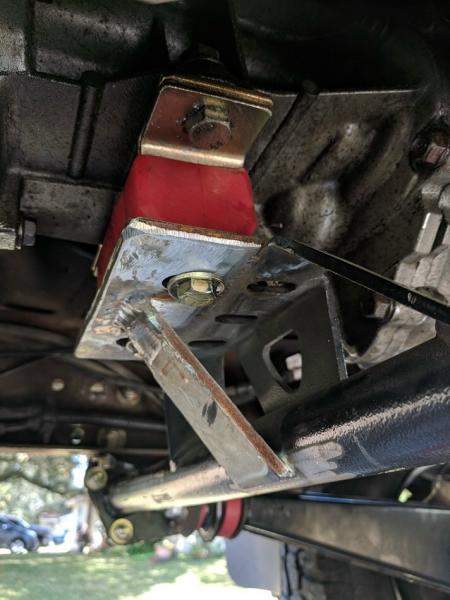Congratulations. If you’re looking at this page, you’re likely contemplating a Dana 44 TTB (Twin Traction Beam) swap in your Ford Ranger. It also means that you’re thinking outside of the box, and haven’t given in to the more common approach of a Dana 44 solid axle swap (SAS). Be prepared for people to lead you in that direction.
The Dana 44 TTB was used in the front of Ford F-150’s and ( full size) Bronco’s from 1980 to 1996.
There is a reason Ford replaced solid axles with independent axles – ride quality. There’s also a reason the TTB suspension finds it’s way in to a lot of high speed off-road race vehicles – wheel travel. The TTB is often chosen over the newer SLA (Short arm Long Arm) suspensions because the long beams are able to provide more wheel travel, dollar for dollar.
Whatever YOUR reason is, we hope that this page will help answer some questions.
FAQs – Widths:
Q – How wide is the Dana 44 TTB?
A -The Dana 44 TTB is 65-inches wide (Wheel Mounting Surface to Wheel Mounting Surface, or WMS-WMS).
Q -How Wide Is The Dana 35 TTB?
A – The Dana 35 TTB is 59.5-inches wide (WMS-WMS)
As you can see, the Dana 44 TTB is 5.5-inches wider than the Dana 35.
How Can I Mount The Axle Beams Under My Ford Ranger:
There are (4) options for doing it:
Option 1) Bolt the Dana 44 TTB straight into your existing brackets, then shorten the passenger side inner axle shaft a total of 1.5 to 2-inches. This will result in a 2-inch narrowing of the whole axle assembly, and a 63-inch WMS-WMS width, which is 3.5-inches wider than the stock Ford Ranger Dana 35 TTB.
In the photo below, you can see the passenger side axle poking through the slip yoke, and bottoming out on the U-joint before the axle shaft is shortened.
The Stock Ford F-150 / Bronco Dana 44 TTB passenger side inner axle shaft is 24.77-inches long. The Dana 44HD (Heavy Duty) TTB used in the 1980-1988 Ford F-250 and F-350 has a 23.65-inch passenger side inner axle shaft, which is 1.12-inches shorter. Cutting off 0.625-inches (5/8-inch) would make it 1.745-inches (1-3/4-inch) shorter than the stock Dana 44 TTB passenger side inner axle shaft, and would require you to cut off less material than on the stock shaft.
If you cut the axle down with a chop saw, you can de-burr the axle and add the factory tapered edge back by rotating the axle at an angle against the edge of the chop saw blade.
Option 2) Modify your existing brackets by drilling a new hole 1-inch inboard (towards the center of the vehicle) of the existing holes, and mount the axle in the new holes. This will preserve the 65″ width and will not require shortening of the shafts. Some brackets may not have enough room for the new holes though.
Option 3) Autofab and Giant Motorsports make a bracket kit to mount the Dana 44 TTB in to a 1983-1997 Ford Ranger 4×4. Giant Motorsports actually sells this as a complete kit, where Autofab just sells the brackets.
Autofab states that you will end up with a front axle assembly that’s 8-inches wider than stock.
The Giant Motorsports kit allows for a 5-inch lift.
These brackets mount in the stock location of the original factory brackets. This follows along with #2 above, except with newly spaced holes instead of drilling new holes in old brackets.
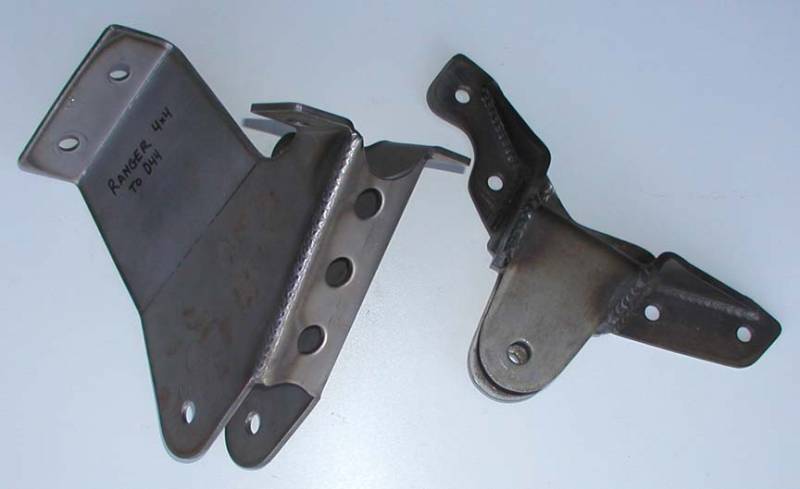
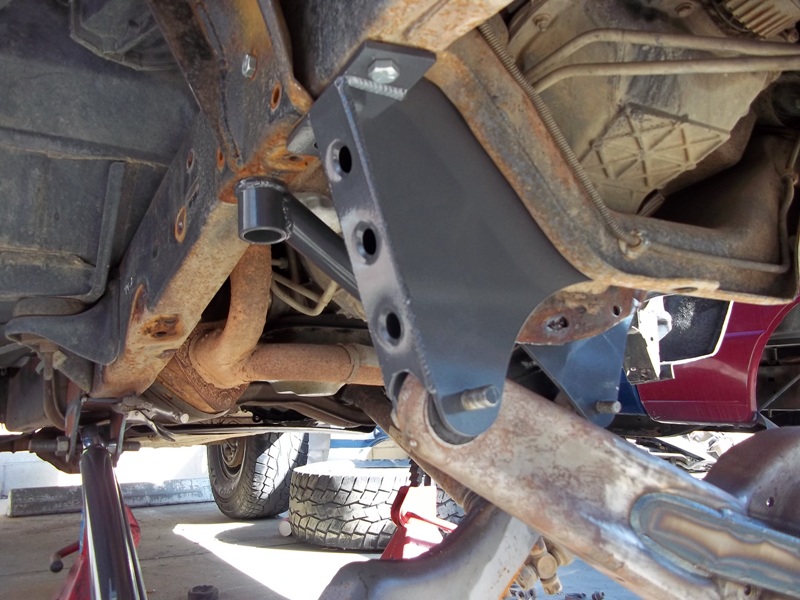
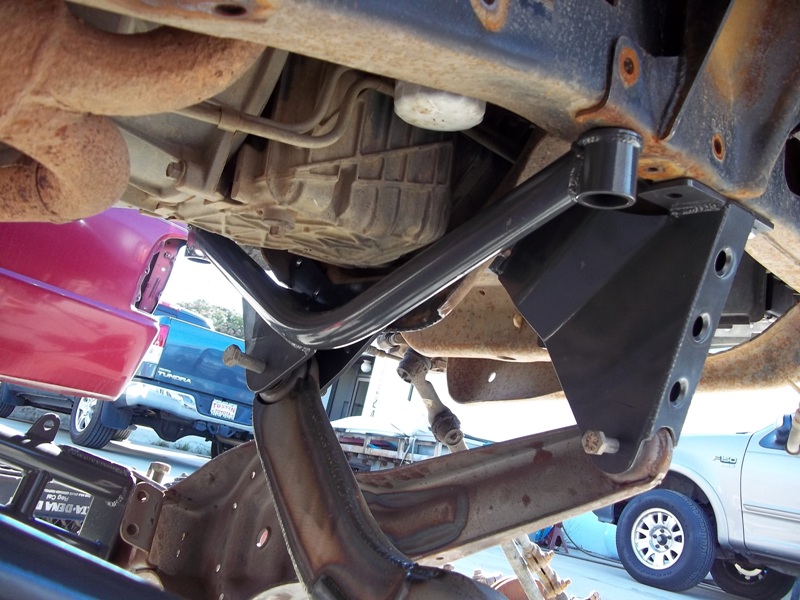

Option 4) Extend the Dana 44 TTB beams 1-inch on each side at the pivot end, and then bolt them into your existing brackets. (probably the best method). Yes that’s right, we’re actually suggesting that you widen you’re full width Dana 44 TTB beams.
Q- Why?
A- Although the F-150 / Bronco frame is wider than the Ford Ranger, the actual pivot mounts for the TTB axle beams are 2-inches narrower on the F-150 / Bronco then they are on a Ford Ranger. Since the Ranger brackets are actually spaced further apart, you actually need to lengthen each of the beams 1-Inch so they will reach the mount, and not require the passenger side axle shaft to be shortened as mentioned in Option #1 above.
Also, you’ll have to be concerned about the Dana 44 differential clearing the frame rail as the suspension cycles up. Hopefully you’re using at least a 4-inch lift, although most people seldom have less than 4-inches of lift. You should also consider bump stops.
The photo below is for reference only. This is clearly lengthened more than 1-inch, but it allows a visual suggestion so you get the idea.
The Radius Arms
You can use the Ford Ranger radius arms on the Dana 44 TTB, so if you’ve spend money on extended radius arms, don’t panic. You will end up needing to use a 1/8 shim or washer between the axle beam and mount.
You will have to angle the radius arms in towards the frame more than you do with a Ford Ranger axle. If you’re using longer radius arms, the angle won’t be as great. You may find it difficult trying to get everything to line up and cycle properly with the stock arms.
Coil Spring Mounts
The coil bucket (upper mount) will likely need to be spaced 1-2 inches outward to line up with the lower mount, or you may be able to make a new mount further in on the beam towards the differential. Relocating the upper mount may be the better option, unless you want to get rid of the coil springs completely and go with coilovers. You’ll obviously need to make custom upper and lower mounts for those.
Steering
There’s no clear answer here. It depends on the method you used to install the axle beams, and the widths you’re working with. If you bolt the beams in to Ford Ranger brackets and shorten the passenger side inner axle shaft, you might be able to use the stock Ford Ranger steering linkage. It will obviously need to be adjusted. Otherwise, you’re simply going to have measure, and buy new draglinks that are the proper lengths. You may want to use the stock linkage in place, and use the drag links as a guide for measuring how much more length you need.
One very important note though is the tie rod ends (TRE). If you look closely at the photos below, you’ll see that the tie rod ends on the steering linkage mount BELOW the steering knuckle on the Ford F-150 / Bronco Dana 44 TTB. The Steering linkage tie rod end mounts (ABOVE) the steering knuckle on the Ford Ranger Dana 28 and Dana 35 TTB.
You’ll want to ream out the top of the knuckle so you can mount your steering linkage on top instead of the bottom. You’ll need a reamer with a 7-degree taper, which is also expressed as 1-1/2 inches of taper per foot.
Below is a side by side comparison of a spiral-flute reamer on the left, and a straight-flute reamer on the right. The advantages of the spiral-flute reamer are more apparent. The straight-flute reamer has a four-sided shank and is not meant to be chucked into a drill; hand turning is the only option. Cutting oil is a must with either reamer.
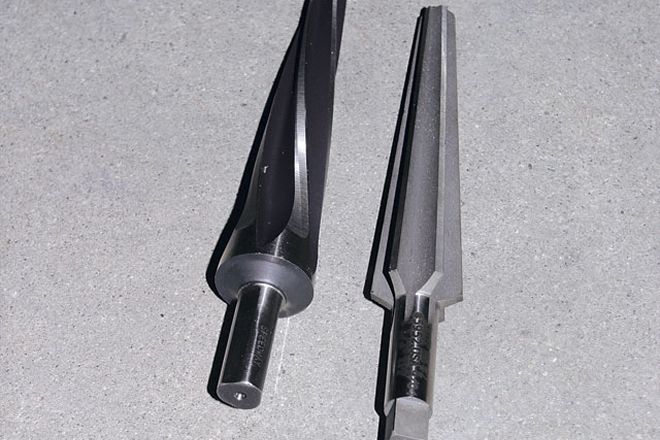
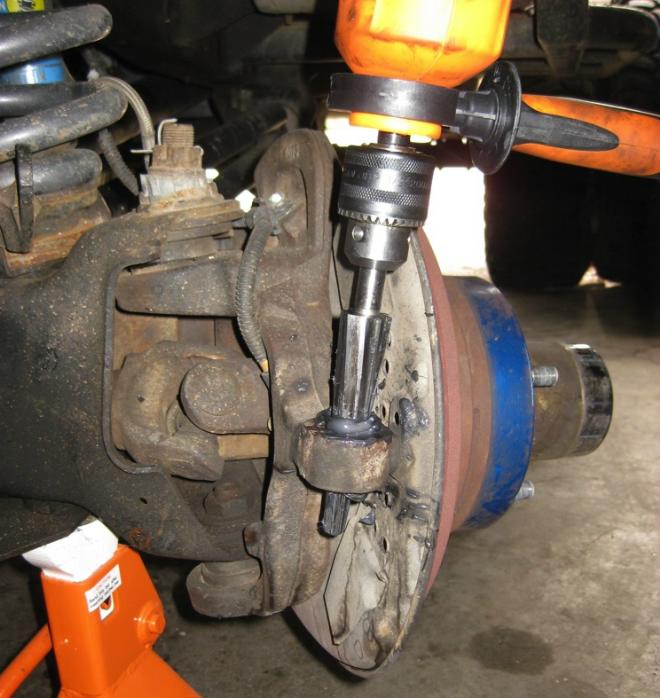
Covering The Wider Axles / Tires
Today, companies like Autofab, McNeil Racing, and Fiberwerx offer wider fiberglass fenders and bedsides for Ford Rangers for situations such as this. Therefore, if you decide to go with a full width rear axle to match the front, they have you covered back there as well.
McNeil Racing and Fiberwerx offer fiberglass for the different Ford Ranger body styles, as well as fiberglass kits to upgrade Ford Rangers to a newer style.
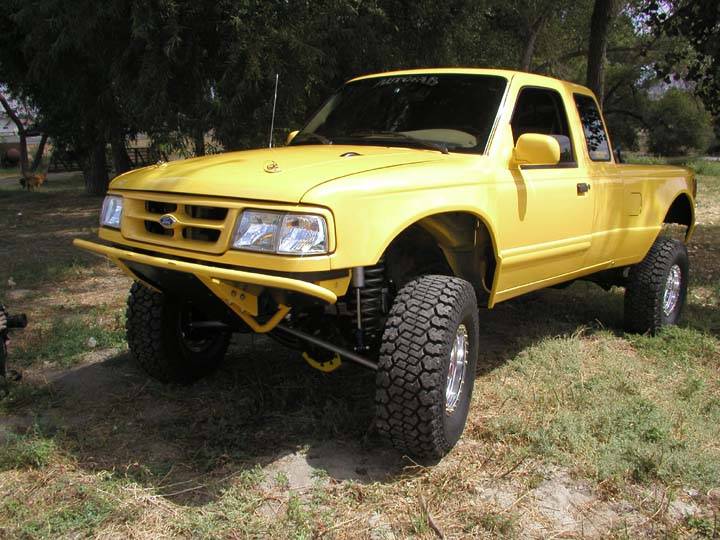
More Visual Reference
This is a stock Dana 44 TTB that has been bolted in to a Ford Ranger using the 6-inch Skyjacker Suspension lift that was already in place. The actual differential and axle shafts are not installed. This is a mock-up.
You can see the angle (photo below) that the coil spring is placed at using the factory Ford Ranger upper coil bucket. This can be resolved (3) different ways:
1) Space the coil bucket out from the frame with either a spacer, or custom mount
2) Build a new lower mount on the axle beam closer to the differential so it’s inline with the upper mount
3) Replace the coil springs with a coil over setup and custom mounts
You can clearly see that the point on the axle where the coil spring and radius arm (under the coil spring) mount are wider than the stock Ford Ranger setup.
According to the owner:
I had to move the Skyjacker radius arm brackets 1.5-inches forward to allow the wheels to be centered in the wheel wells. This was necessary because at full lock turn the tires were chewing up the lower fender wells just in front of the doors. Since the beams are 3-inches wider on either side, they were pulled back ever so slightly due to the arc created… While the radius arms did not change length, the position of the beams did. The transmission mounting point had to be modified and moved back 1.5-inches.
You can see where he moved the radius arm bracket forward in the photo below:
As far as the steering, he says:
The tie rod ends and drag links are from a 1990 Ford F-150. An inch needed to be cut off of the right side tie rod end and adjoining drag link. The adjuster sleeve needed an inch cut off of either side. There is still plenty of room for the clamps to tighten and ample thread engagement. The left side is unmodified.
The knuckles were reamed from the top to accept the tie rod ends. The reamer is a XKUT 1-1/2″ TPF BALL JOINT & TIE ROD TAPER REAMER #6952. Easily found on EBay. Be careful to not over ream or the TRE’s will not tighten up… Slow and easy with several trial fits.
I used a 6-inch drop pitman arm for the steering. I think it was a FA600 from Skyjacker. As you can see in the last photo, the steering linkage is nearly parallel. With the Dana 44 beams, you want the axle beam eye bolts to be 1-inch higher that the spindle centerline. This sets the proper ride height and make alignment much easier. The alignment bushings are MOOG part #’s K80108.
If your smart, you wont lose the F150 sway bar link mounts like I did. I had to cut down the factory Dana 35 mounts.
It is necessary to add a 1/8-inch shim between the radius arm to beam mounts. The Dana 44 beams are 1/8-inch thinner where the radius arms mount. I used a set of washers that came from the D35 beams. The bolts (both upper and lower) come with these. If you grabbed them from your Dana 44 TTB donor you are in luck.
Links:
Dennys Driveshafts carry Dana 44 TTB and Dana 44 TTB HD axle shafts.
Thanks:
Thanks to Forum Staff Member 4x4Junkie, and our other forum members that have contributed to this discussion over the years.
Have Information To Add?
If you have more information to add that might help someone else with this swap, please let us know.

